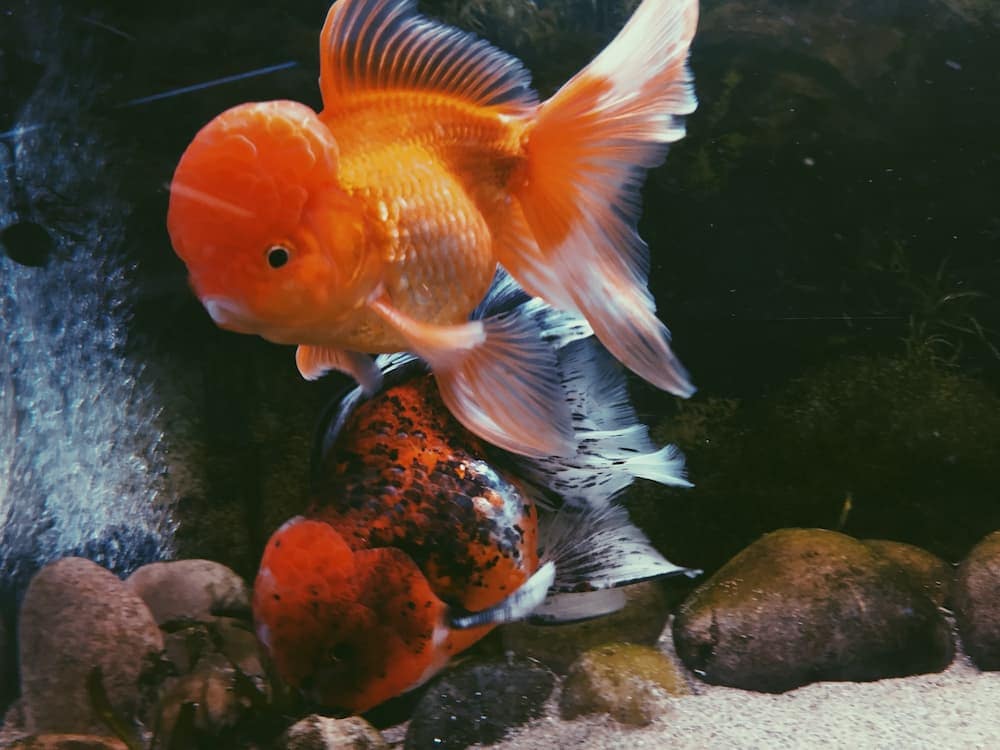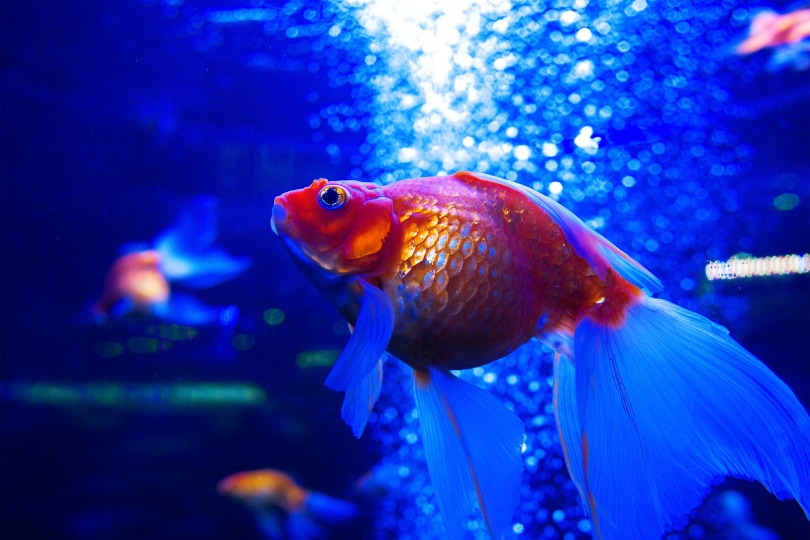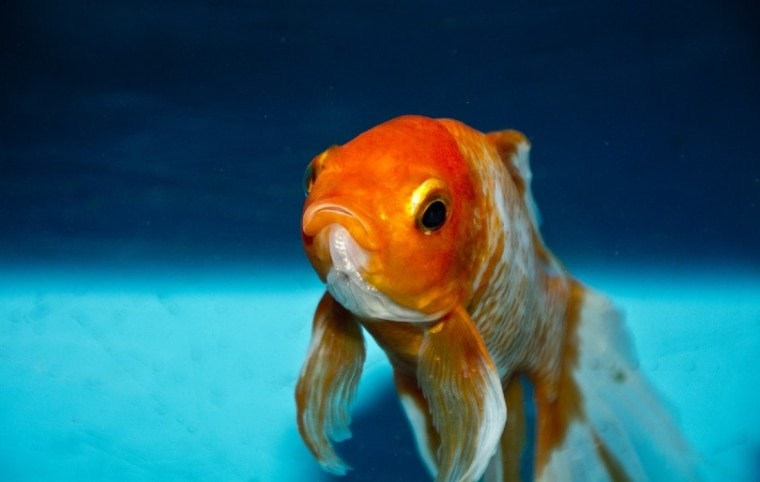
Click to Skip Ahead
Goldfish are a common beginner fish because of their striking coloration and low price. But don’t let that fool you into thinking they are a short-term pet! In fact, goldfish are one of the longest-lived domestic fish breeds. Most goldfish should live more than 10 years in captivity, provided they are in a safe and healthy environment.
 What’s the Average Lifespan of a Goldfish?
What’s the Average Lifespan of a Goldfish?
Goldfish can live a long time! The average goldfish lifespan differs from variety to variety, but a healthy goldfish in a safe environment should live about 10-15 years. Some varieties of goldfish live even longer, with lifespans of up to 30 years. Sadly, many goldfish do not live this long. Poor living conditions and lack of proper care can dramatically shorten a goldfish’s lifespan.
Why Do Some Goldfish Live Longer Than Others?
Although a healthy goldfish should live at least 10 years, many goldfish do not live this long. Health issues can arise from a variety of sources, but most of the factors that shorten goldfish lifespans are in the owner’s control. Improper environmental conditions are the number one cause of premature death in goldfish.
Healthy goldfish are brightly colored and have erect fins. They are active and will spend much of their time swimming throughout the tank. A goldfish that has dull or dark coloration, drooping or tattered fins, or stays on the bottom of the tank or in one place likely has unmet needs and is at risk of premature death. Here are some of the reasons some goldfish might live longer than others:
1. Nutrition
Specialized goldfish foods are designed to provide a good nutritional base for goldfish. Although goldfish can thrive on only one type of food, many goldfish are happiest and healthiest when fed a variety of flakes and pellets. Their diet can also be supplemented by live or frozen brine shrimp. Goldfish should be fed two to three times a day.
Overeating is a major problem for goldfish. Goldfish who are overfed will often suffer from health complications and shortened lifespans. A good rule of thumb is that goldfish should be fed only as much as they can eat in two minutes. After two minutes, any uneaten food should be removed from the tank to prevent decomposition or overeating.

2. Water Quality
Goldfish will live longer in a tank that meets their optimum environmental needs. A living environment that has the correct temperature and water quality is important for your goldfish’s health.
Goldfish are most healthy in water that is 68-75° Fahrenheit (20-24° C) although they can survive for short times in colder or warmer water. Because most homes have air within that temperature range, a tank heater is usually not necessary. However, it is important to monitor tank temperature and watch for unexpected heating sources, such as direct sunlight or nearby heat sources.
Goldfish produce a high volume of waste in the form of ammonia, nitrites, and nitrates. These waste products will build up in the water without proper filtration. Your tank’s filter should be designed for the capacity of your tank. Tank filters should be cleaned as needed or about monthly to keep them functioning correctly, and partial water changes should be performed about once a week. When performing a water change, remove about 20-25% of the water in the tank. Use a siphon to clean any tank gravel or substrate. Replace with fresh water that has been treated with conditioner.
If you are looking for help to get the water quality just right for your goldfish family in their aquarium, or just want to learn more about goldfish water quality (and more!), we recommend you check out the best-selling book, The Truth About Goldfish, on Amazon today. It covers everything from water conditioners to tank maintenance, and it also gives you full, hard copy access to their essential fishkeeping medicine cabinet!
3. Tank Size
Goldfish should be kept in a tank of about 15 gallons (50 liters) or more. That’s a lot more space than your average fishbowl! In addition to the gallon capacity, the tank must be big enough for your fish in every dimension. Fish tanks can be measured against your fish’s adult body length to know how big it should be. Your tank should be at least three times as tall as your goldfish’s adult body length, two times as wide as your fish’s adult body length, and four times as long as your fish’s adult body length.
If your fish is not fully grown, you can look up your fish’s specific variety to get a good size estimate. These dimensions are important because they give your fish plenty of space to be active, turn around, and have plenty of hiding spots. A tank that is too narrow or shallow will negatively impact your goldfish’s overall health because he won’t have the space for proper exercise.

4. Other Environmental Conditions
Goldfish are happiest and healthiest in an environment that is both safe and stimulating. Plant cover can improve the water quality in your tank and provide an enriching environment for goldfish. Because goldfish have many natural predators, a lack of cover can increase stress and lower activity. This cover should include real or imitation plants along with other types of cover such as driftwood, rock hides, and other decorations. Some goldfish enjoy playing with toys such as floating balls.
Although an empty tank isn’t a good long-term home for a goldfish, everything that goes into a goldfish tank should be carefully assessed for safety. Don’t include anything in your tank that has sharp edges a fish could get cut on or openings too small for your fish to safely swim through.
5. Size
Goldfish are indeterminate growers. That means that they will continue growing throughout their lives if given room. Although the healthy adult size depends from goldfish to goldfish, this size is not a maximum and healthy goldfish may continue to keep growing as they age. Goldfish with the space to grow larger are often healthier and longer-lived.

6. Sex
Although there isn’t a definitive answer to this one, many online sources claim that female goldfish live slightly longer than males. This variation is fairly slight if it exists at all, so both male and female goldfish can be expected to live 10-15 years.
7. Genes
Some varieties of goldfish live longer than others. In general, goldfish with highly modified tails, eyes, and other characteristics will not live for as long as more natural breeds. For example, Bubble Eye Goldfish have been bred to have large sacs behind their eyes. These sacs are visually striking, but they come with severe health drawbacks including vision difficulties and restricted movement. Because of this, Bubble Eye Goldfish often live to only about 5-8 years. If you decide to buy a fancy goldfish breed, make sure to research any health concerns that might come with that breed.
How Can I Ensure My Goldfish Lives a Long Life?
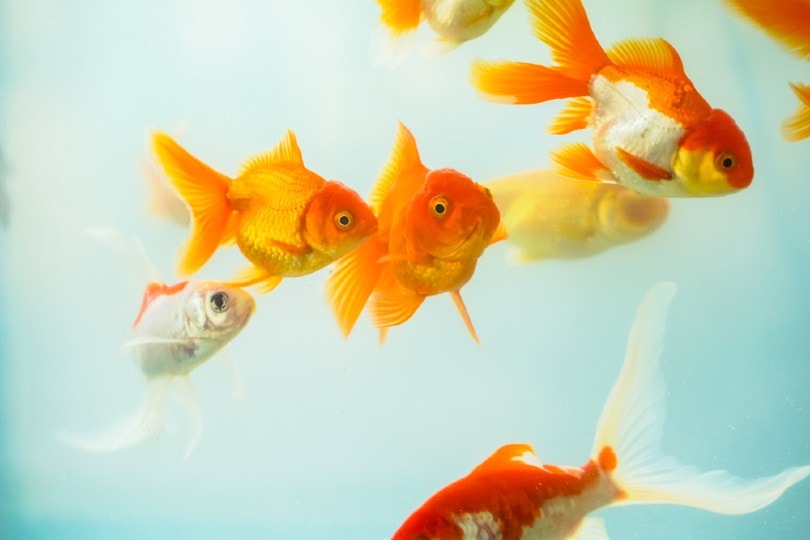
What About Pond Goldfish?
This might come as a big surprise, but goldfish that live in ponds tend to live longer lives than goldfish kept in aquariums. This is because they go through torpor annually and ponds usually allow a large amount of swimming space in an enriching environment. Goldfish kept in ponds are at a higher risk of predation, though, so it’s important to make sure your pond environment is set up to protect your fish from cats, birds of prey, and other predators.

The 5 Life Stages of a Goldfish
1. Egg
Goldfish lay eggs in clutches of about 25 at a time, usually attached to plants. Inside the eggs, the embryos develop for about 3-5 days before hatching.
2. Fry
Goldfish young are called fry. When they emerge from their eggs, they are tiny and translucent. They spend their first few days of life clinging to the plants their eggs were laid on before going to look for food. During the first weeks of life, fry grow rapidly. They develop fins at about two weeks of age and spend much of their time swimming and searching for food.
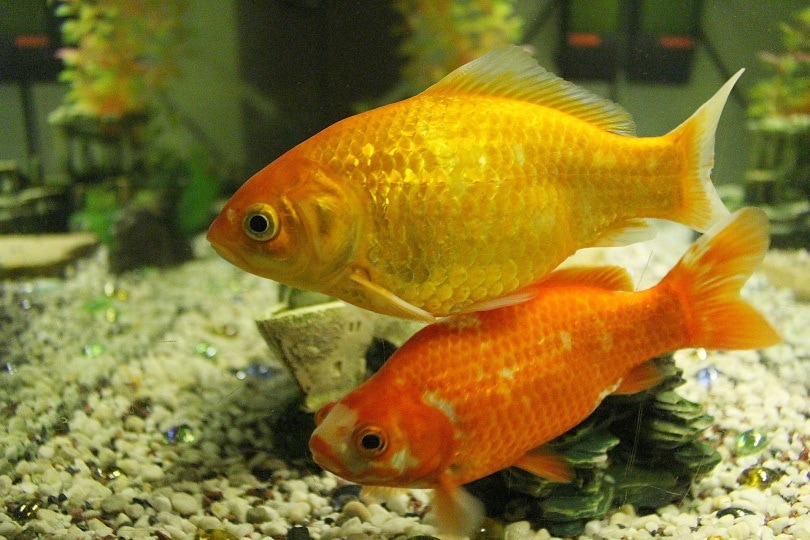
3. Juvenile
As fry grow into juveniles, their color will start out at a dark brownish-bronze and grow lighter over time. Juvenile goldfish generally have rounded tail fins instead of the forked tails that adult goldfish have. Most juveniles will reach their final adult color around one year of age.
4. Adult
Adult goldfish are generally a warm orange or gold color. They will continue growing throughout their life, although that growth slows down dramatically when they reach adulthood and will slow even more as they reach the limits of their tank size.
5. Senior
As goldfish reach their final years of life, their growth slows down even in a large tank. They might begin losing color, lightening to white or cream, and they will become less active. Senior goldfish usually eat less over time as well.

How To Tell Your Goldfish’s Age
It can be difficult to tell your adult goldfish’s age. In a lab, scientists can look at goldfish scales in a microscope to tell the fish’s age. Goldfish scales will have rings like tree rings that scientists can count. That’s not something most of us can do at home, so the best we can get is a general stage of life for the most part.
Juvenile goldfish are a bronze or brownish color and reach their adult color around one year of age. Most goldfish in pet stores are around 1-2 years of age. Once goldfish are mature, environmental factors can make it difficult to tell how old your goldfish is. Although goldfish keep growing throughout their life, this speed varies depending on the environment. Senior goldfish may be paler in color and less active than young goldfish—if your fish was once deep orange or gold and is now growing lighter, it is likely at least ten years old.
 Conclusion
Conclusion
Goldfish are incredible pets who can live long and healthy lives. Whether your fish still hasn’t reached adult colors or is a creamy-scaled senior, proper environmental care is vital to making a healthy, happy fish. And be prepared for your goldfish to really be part of the family—the average goldfish will live for 10-15 years if properly cared for.
Related Reads:
Featured Image Credit: Narcis Ciocan, Pixabay

 What’s the Average Lifespan of a Goldfish?
What’s the Average Lifespan of a Goldfish?
